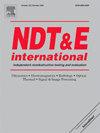面向近表面缺陷高精度定位的多方向剪切成像
IF 4.5
2区 材料科学
Q1 MATERIALS SCIENCE, CHARACTERIZATION & TESTING
引用次数: 0
摘要
剪切成像技术是工程材料近表面缺陷检测和定位的有效技术。然而,作为剪切学的关键实验参数,加载幅度和剪切幅度都可能导致定位误差甚至误判。尽管现有的基于剪切图的方法在缺陷定位方面取得了进展,但在实现高定位精度和鲁棒性方面仍然存在挑战。为了应对这些挑战,我们提出了一个结合两个关键创新的新框架:(1)一个多向剪切成像系统,以分离和消除剪切幅度引起的误差;(2)一个最佳加载幅度选择准则,以抑制加载幅度引起的误差。使用我们的方法,我们在包含三种类型缺陷的测试对象上执行缺陷定位。实验结果表明,在合适的加载幅度范围内,我们的方法在缺陷区域的相对误差为3.6%(表明尺寸精度),平均相交比并为0.8156(反映了与地面真实的重叠一致性)。对多向剪切成像的关键参数进行了分析,对高宽比极值缺陷进行了定位,验证了该方法的优越性。本文章由计算机程序翻译,如有差异,请以英文原文为准。
Multi-directional shearography for high-precision localization of near-surface defects
Shearography is an effective technique for detecting and localizing near-surface defects in engineering materials. However, as critical experimental parameters in shearography, both the loading magnitude and shearing magnitude can lead to localization errors or even misjudgment. Although existing shearography-based approaches have made progress in defect localization, challenges remain in achieving both high localization accuracy and robustness. To address these challenges, we propose a novel framework combining two key innovations: (1) a multi-directional shearography system to separate and eliminate errors caused by shearing magnitude, and (2) a criterion for optimal loading magnitude selection to suppress errors caused by loading magnitude. Using our method, we performed defect localization on a test object containing three types of defects. Experimental results demonstrate that, within a suitable range of loading magnitude, our method achieves a relative error of 3.6 % in the defect area (indicating size accuracy) and an average intersection over union of 0.8156 (reflecting overlap consistency with ground truth). Furthermore, key parameters of multi-directional shearography are analysis, and defects with extreme aspect ratios are localized, demonstrating the superior performance of our method.
求助全文
通过发布文献求助,成功后即可免费获取论文全文。
去求助
来源期刊

Ndt & E International
工程技术-材料科学:表征与测试
CiteScore
7.20
自引率
9.50%
发文量
121
审稿时长
55 days
期刊介绍:
NDT&E international publishes peer-reviewed results of original research and development in all categories of the fields of nondestructive testing and evaluation including ultrasonics, electromagnetics, radiography, optical and thermal methods. In addition to traditional NDE topics, the emerging technology area of inspection of civil structures and materials is also emphasized. The journal publishes original papers on research and development of new inspection techniques and methods, as well as on novel and innovative applications of established methods. Papers on NDE sensors and their applications both for inspection and process control, as well as papers describing novel NDE systems for structural health monitoring and their performance in industrial settings are also considered. Other regular features include international news, new equipment and a calendar of forthcoming worldwide meetings. This journal is listed in Current Contents.
 求助内容:
求助内容: 应助结果提醒方式:
应助结果提醒方式:


